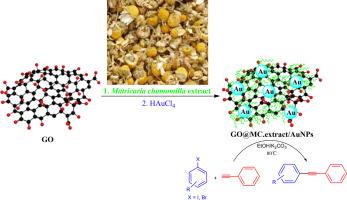Bio-supported gold nanoparticles over the modified graphene oxide as efficient nanocatalyst for Sonogashira coupling reactions
IF 2.1
3区 化学
Q3 CHEMISTRY, INORGANIC & NUCLEAR
引用次数: 0
Abstract
A new and environmentally friendly procedure to form gold nanoparticles combined with graphene oxide using Matricaria chamomilla extract has been developed. The natural components in Matricaria chamomilla extract helped to convert gold ions into gold on the surface of graphene oxide, leading to the generation of the [email protected]/AuNPs material. This material was studied using different methods like TEM, FE-SEM, EDX, ICP, XRD, and elemental-map data. TEM pictures showed that the Au NPs were round, evenly sized, and about 20–30 nanometers wide. The ability of the [email protected]/AuNPs material to help make different alkyne compounds was tested through Sonogashira coupling reactions. The used approach is easy to work with, takes a short time, and gives well to excellent results. The catalyst worked well and did not show much decrease in its ability to be used repeatedly for 7 times.

修饰氧化石墨烯上的生物负载金纳米颗粒作为Sonogashira偶联反应的高效纳米催化剂
研究人员开发了一种新的环保方法,利用洋甘菊提取物与氧化石墨烯结合形成金纳米颗粒。洋甘菊提取物中的天然成分有助于将氧化石墨烯表面的金离子转化为金,从而生成[email protected]/AuNPs材料。采用TEM、FE-SEM、EDX、ICP、XRD和元素图等方法对该材料进行了研究。TEM图像显示Au NPs呈圆形,大小均匀,宽度约为20-30纳米。通过Sonogashira偶联反应测试了[email protected]/AuNPs材料帮助制造不同炔化合物的能力。所使用的方法易于使用,耗时短,效果好。该催化剂效果良好,重复使用7次的性能没有明显下降。
本文章由计算机程序翻译,如有差异,请以英文原文为准。
求助全文
约1分钟内获得全文
求助全文
来源期刊

Journal of Organometallic Chemistry
化学-无机化学与核化学
CiteScore
4.40
自引率
8.70%
发文量
221
审稿时长
36 days
期刊介绍:
The Journal of Organometallic Chemistry targets original papers dealing with theoretical aspects, structural chemistry, synthesis, physical and chemical properties (including reaction mechanisms), and practical applications of organometallic compounds.
Organometallic compounds are defined as compounds that contain metal - carbon bonds. The term metal includes all alkali and alkaline earth metals, all transition metals and the lanthanides and actinides in the Periodic Table. Metalloids including the elements in Group 13 and the heavier members of the Groups 14 - 16 are also included. The term chemistry includes syntheses, characterizations and reaction chemistry of all such compounds. Research reports based on use of organometallic complexes in bioorganometallic chemistry, medicine, material sciences, homogeneous catalysis and energy conversion are also welcome.
The scope of the journal has been enlarged to encompass important research on organometallic complexes in bioorganometallic chemistry and material sciences, and of heavier main group elements in organometallic chemistry. The journal also publishes review articles, short communications and notes.
 求助内容:
求助内容: 应助结果提醒方式:
应助结果提醒方式:


